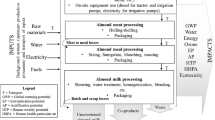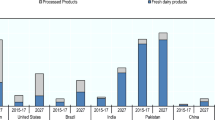Abstract
The objective of the present study was to determine the influences of temperature, humidity, and temperature–humidity index (THI) on piglet preweaning mortality in a conventional open-housing system commercial swine herd in Thailand. The analyzed data included 11,157 litters from 3574 Landrace × Yorkshire crossbred sows. The daily temperature, humidity, and THI data were collected from a meteorological station near the herd. The associations between temperature, humidity, and THI for periods before and after farrowings and piglet preweaning mortality were analyzed. Piglet preweaning mortality (log transformation) and the proportion of litters with piglet preweaning mortality greater than 20% were analyzed by using general linear mixed models and generalized linear mixed models (GLIMMIX), respectively. On average, the piglet preweaning mortality and the proportion of litters with piglet preweaning mortality greater than 20% were 14.5% (14.2 to 14.8% CI) and 26.4% (25.5 to 27.2% CI), respectively. Piglet preweaning mortality was positively correlated with the mean temperature (r = 0.028, P = 0.003), humidity (r = 0.038, P < 0.001), and THI (r = 0.036, P < 0.001) during 0–7 days postpartum. In primiparous sows, piglet preweaning mortality increased from 12.1 to 18.5% (+ 6.4%, P < 0.001) when the mean temperature during 0–7 days postpartum increased from < 25.0 to ≥ 29 °C. However, the influence of the temperature during 0–7 days postpartum was insignificant in multiparous sows (P = 0.569, P = 0.593, and P = 0.539 in sows parity numbers 2, 3–5, and 6–9, respectively). Likewise, piglet preweaning mortality increased from 10.7 to 16.7% (+ 6.0%, P = 0.012) when humidity during 0–7 days postpartum increased from < 60 to ≥ 80% in primiparous sows but it was insignificant in sows parity numbers 3–5 (P = 0.095) and 6–9 (P = 0.219). Moreover, the proportion of the litters with piglet preweaning mortality greater than 20% in primiparous sows increased from 18.3 to 32.4% (+ 14.1%, P = 0.017) when the THI during 0–7 days postpartum increased from < 73 to ≥ 81. In conclusion, the negative influences of temperature, humidity, and THI on piglet preweaning mortality were more evident in primiparous than multiparous sows. These findings implied that strategies to reduce temperature for postpartum sows in the open-housing system in Thailand are inadequate, and the proper management of postpartum primiparous sows should be emphasized.






Similar content being viewed by others
References
Baxter, E.M., Jarvis, S., Sherwood, L., Robson, S.K., Ormandy, E., Farifh, M., Smurthwaite, K.M., Roehe, R., Lawrence, A.B., Edwards, S.A., 2009. Indicators of piglet survival in an outdoor farrowing system. Livestock Science, 124, 266–276.
Bloemhof, S., van der Waaij, E.H., Merks, J.W.M., Knol, E.F., 2008. Sow line differences in heat stress tolerance expressed in reproductive performance traits. Journal of Animal Science, 86, 3330–3337.
Brown-Brandl, T.M., Eigengerg, R.A., Nienaber, J.A., Kachman, S.D., 2001. Thermoregulatory profile of a newer genetic line of pigs. Livestock Production Science, 71, 253–260.
Carney-Hinkle, E.E., Tran, H., Bundy, J.W., Moreno, R., Miller, P.S., Burkey, T.E., 2013. Effect of dam parity on litter performance, transfer of passive immunity, and progeny microbial ecology. Journal of Animal Science, 91, 2885–2893.
De Rensis, F., Ziecik, A.J., Kirkwood, R.N., 2017. Seasonal infertility in gilts and sows: Aetiology, clinical implications and treatments. Theriogenology, 96, 111–117.
Devillers, N., Farmer, C., Le Dividich, J., Prunier, A., 2007. Variability of colostrum yield and colostrum intake in swine. Animal, 1, 1033–1041.
Farmer, C., Prunier, A., 2002. High ambient temperatures: how they affect sow lactation performance. Pig News and Information, 23, 95N–102N.
Ferrari, C.V., Sbardella, P.E., Bernardi, M.L., Coutinho, M.L., Vaz, Jr. I.S., Wentz, I., Bortolozzo, F.P., 2014. Effect of birth weight and colostrum intake on mortality and performance of piglets after cross-fostering in sows of different parities. Preventive Veterinary Medicine, 114, 259–266.
Herpin, P., Damon, M., Le Dividich, J., 2002. Development of thermoregulation and neonatal survival in pigs. Livestock Production Science, 78, 25–45.
Jaichansukkit, T., Suwanasopee, T., Koonawootrittriron, S., Tummaruk, P., Elzo, M.A., 2017. Effect of daily fluctuations in ambient temperature on reproductive failure traits of Landrace and Yorkshire sows under Thai tropical environment conditions. Tropical Animal Health and Production, 49, 503–508.
Kelly, C.F., Bond, T.E., 1971. Bioclimatic factors and their measurement. In A Guide to nvironmental research on animals (Eds R. G. Yeck, R. E. McDowell, T. E. Bond, R. W. Dougherty, T. E. Hazen, H. D. Johnson, J. E. Johnston, C. F. Kelly, N. Pace, S. Y. Smith, L. C. Ulberg and W. O. Wilson), pp. 7–93. Washington, DC: National Academy of Science Press.
Koketsu, Y., Takenobu, S., Nakamura, R., 2006. Preweaning mortality risks and recorded causes of death associated with production factors in swine breeding in Japan. Journal of Veterinary Medical Science, 68, 821–826.
Malmkvist, J., Damgaard, B.M., Pedersen, L.J., Jørgensen, E., Thodberg, K., Chaloupková, H., Bruckmaier, R.M., 2009. Effects of thermal environment on hypothalamic–pituitary–adrenal axis hormones. Journal of Animal Science, 87, 2796–2805.
Marchant, J.N., Rudd, A.R., Mendl, M.T., Broom, D.M., Meredith, M.J., Corning, S., Simmins, P.H., 2000. Timing and causes of piglet mortality in alternative and conventional farrowing systems. Veterinary Record, 147, 209–214.
Muns, R., Tummaruk, P., 2016. Management strategies in the farrowing house to improve piglet pre-weaning survival and growth. The Thai Journal of Veterinary Medicine, 46, 347–354.
Muns, R., Malmkvist, J., Larsen, M.L.V., Sorensen, D., Pedersen, L.J., 2016a. High environmental temperature around farrowing induced heat stress in created sows. Journal of Animal Science, 94, 377–384.
Muns, R., Nuntapaitoon, M., Tummaruk, P., 2016b. Non-infectious causes of pre-weaning mortality in piglets. Livestock Science, 184, 46–57.
National Research Council. 2012. Nutritional Requirements of Swine, 11th ed. National Academy Press, Washington, DC.
Neil, M., Ogle, B., Anner, K., 1996. A two-diet system and ad libitum lactation feeding of the sow. 1. Sow performance. Animal Science, 62, 337–347.
Nuntapaitoon, M., Tummaruk, P., 2015. Piglet pre–weaning mortality in a commercial swine herd in Thailand. Tropical Animal Health and Production, 47, 1539–1546.
Shankar, B.P., Madhusudhan, H.S., Harish, D.B., 2009. Pre-weaning mortality in pig-causes and management. Veterinary World, 2, 236–239.
Silva, B.A.N., Noblet, J., Donzele, J.L., Oliveira, R.F.M., Primot, Y., Gourdine, J.L., Renaudeau, D., 2009. Effects of dietary protein level and amino acid supplementation on performance of mixed-parity lactating sows in a tropical humid climate. Journal of Animal Science, 87, 4003–4012.
Suriyasomboon, A., Lundeheim, N., Kunavongkrit, A., Einarsson, S., 2006. Effect of temperature and humidity on reproductive performance of crossbred sows in Thailand. Theriogenology, 65, 606–628.
Tummaruk, P., Tantasuparuk, W., Techakumpu, M., Kunavongkrit, A., 2004. Effect of season and outdoor climate on litter size at birth in purebred Landrace and Yorkshire sow in Thailand. Journal of Veterinary Medical Science, 66, 477–482.
Tummaruk, P., Tantasuparuk, W., Techakumpu, M., Kunavongkrit, A., 2010. Seasonal influences on the litter size at birth of pigs are more pronounced in the gilt than sow litters. Journal of Agricultural Science, 148, 421–432.
Wegner, K., Lambertz, C., Das, G., Reiner, G., Gauly, M., 2014. Climatic effect on sow fertility and piglet survival under influence of a moderate climate. Animal, 8, 1526–1533.
Funding
The financial support for the present study was provided by a grant for International Research Integration: Chula Research Scholar, Ratchadaphiseksomphot Endowment Fund (GCURS_59_02_31_01). M. Nuntapaitoon is a grantee of the Research and Researchers for Industries (RRI) Ph.D. program, the Thailand Research Fund.
Author information
Authors and Affiliations
Corresponding author
Ethics declarations
Conflict of interest
The authors declare that they have no conflict of interest.
Rights and permissions
About this article
Cite this article
Nuntapaitoon, M., Tummaruk, P. Influences of climatic parameters on piglet preweaning mortality in Thailand. Trop Anim Health Prod 50, 857–864 (2018). https://doi.org/10.1007/s11250-017-1508-0
Received:
Accepted:
Published:
Issue Date:
DOI: https://doi.org/10.1007/s11250-017-1508-0




